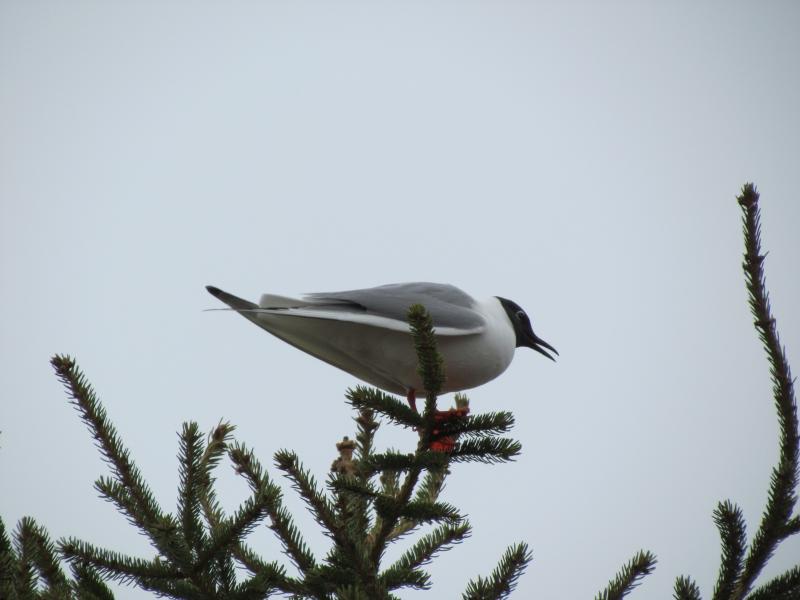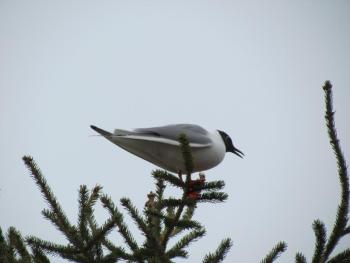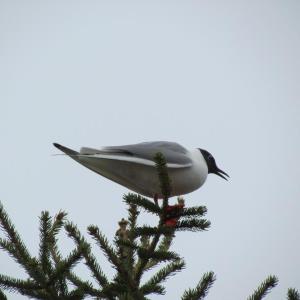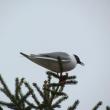Searching for George Ord’s ‘Philadelphia Tern’ (AKA Bonaparte’s Gull)
Turkeys may be the bird on the minds of most people during Thanksgiving week, but we find ourselves instead considering a small, dainty gull (imagine calling any gull “dainty”!) that can be found frequenting the countless small coves, bays, and narrows throughout the Midcoast region.
The Bonaparte’s gull doesn’t fit any preconceptions of the gulls we know—those big, feisty, yellow billed birds that we see following lobster boats, sitting on the top of wharf pilings, and scrapping for garbage at the landfill. You’ll never see a Bonaparte’s gull at the dump. They feed almost exclusively on naturally occurring tiny crustaceans and water-loving invertebrates as well as occasionally gorging on ants in the fall when the flying males depart enmass from their ant nests.
The size of a Bonaparte’s gull is closer to that of a tern or mourning dove, nothing like the brooding bulk of a herring or great black-backed gull.
And the oddities keep mounting.
Except for a handful of very rare and far out-of-range breeding records in far northern Maine, Bonaparte’s gulls nest in the Boreal Forest region of Canada and Alaska. They are one of the few gulls in our area in which the adults have a full black head at the height of breeding condition (a characteristic they share with the more common and familiar laughing gull). While almost all gulls around the world nest on the ground, usually on islands where they have safety from the attacks of mammals, Bonaparte’s gulls nest exclusively in trees. The millions of lakes and countless miles of rivers and streams across the Boreal Forest region provide the perfect places where the birds can find spruce trees or other coniferous trees near water to place their nests. It is a startling sight in late May and early June around these Boreal lakes and ponds to see these handsome black-headed gulls bouncily flying around with twigs in their bills and then diving into the depths of the green branches of a spruce where they’re building the nest.
Just as fascinating as its life history is the history of its name. The first specimen and description of the bird by Western Science (no doubt Native Americans must have been very familiar with the species long before then), was a bird collected by early ornithologist George Ord of Philadelphia in 1815. Ord gave the bird the scientific name of Sterna philadelphia, assuming that since it was so small it must belong in with the terns rather in the genus Larus, with the big gulls. Today, modern genetic techniques suggest that the birds should be in their own genus, neither big gulls nor tiny terns but something in between.
An interesting fact about Ord is that he was a friend and disciple of the early American ornithologist Alexander Wilson who predated John James Audubon on the American ornithology scene. Wilson died in 1813 before he could complete his intended thorough work on the birds of North America. Ord resented John James Audubon’s ambitious project to illustrate and complete the definitive work on North American birds, which he thought (somewhat correctly) would supersede Wilson’s many-volume reference.
A French ornithologist named Charles Bonaparte (a nephew of the famous Napoleon Bonaparte) came to the Philadelphia area in 1823 and stayed for about five years. He was a strong supporter of fellow Frenchmen John James Audubon and he lobbied to get Audubon into the membership of the Philadelphia Academy of Natural Science but was blocked by George Ord and other Wilson supporters.
Later, this bird that could have been called the “Philadelphia gull” was referred to by some friends of Charles Bonaparte in 1832 as Bonaparte’s gull and the name persisted. We can’t help but wonder whether there was some behind-the-scenes attempt at revenge against George Ord by giving a species he had first collected and identified an English name honoring an apparent enemy.
In your after-turkey Thanksgiving haze, we hope you will find the time for a walk along the shore and that you may find and enjoy watching some of George Ord’s decidedly un-gull-like gulls.
Jeffrey V. Wells, Ph.D., is a Fellow of the Cornell Lab of Ornithology and Vice President of Boreal Conservation for the National Audubon Society. Dr. Wells is one of the nation's leading bird experts and conservation biologists and author of “Birder’s Conservation Handbook”. His grandfather, the late John Chase, was a columnist for the Boothbay Register. Allison Childs Wells, formerly of the Cornell Lab of Ornithology, is a senior director at the Natural Resources Council of Maine, a nonprofit membership organization working statewide to protect the nature of Maine. Both are widely published natural history writers and are the authors of the book, “Maine’s Favorite Birds” and “Birds of Aruba, Bonaire, and Curaçao: A Site and Field Guide” from Cornell Press.
Event Date
Address
United States

























